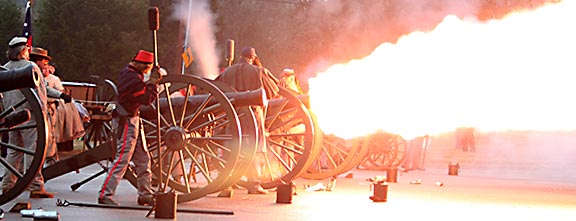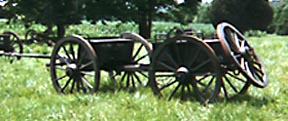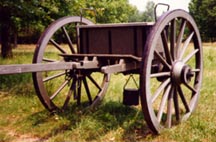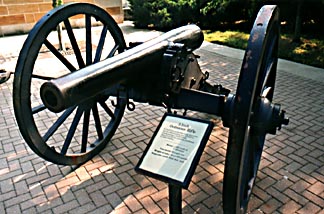Field Artillery
Many different types of field artillery were used by both sides during the War.
Viewable here are six common field pieces
as well as the different types of ammunition, and the limbers and caisson used
Field Artillery Ammunition
Four types of artillery shells (left to right):
- Solid Shot (round ball) with 20-oz. powder charge (fixed ammo)
- Canister (fixed) filled with 27 one-inch iron balls
for close-quarter “shotgun” effect - Conical solid shell for accurate, long-distance rifled guns
- Spherial hollow iron shell filled with black powder bursting charge
Field Artillery Limber and Caisson
Limbers were used to haul cannons and carry ammunition
(50 rounds of six-pound shells) and fuses.
A limber connected to a caisson,
which carried two ammo boxes and a spare wheel.
Field Artillery No. 1
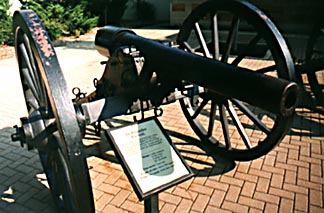
Ten-Pound Parrott Field Rifle
Patented in 1861 by Robert P. Parrott and produced at West Point Foundry.Identified by cast iron band around the breech. Model 1863 shown; 1861 Model had muzzle swell. Also produced in a 20-pounder version. Mostly used to fire shell and case, sometimes a solid iron bolt. Canister ammo was not as effective because the rifled barrel tended to shoot the canister balls in erratic patterns. Three inch bore diameter; 78 inch cast iron tube weighing 890 lbs. One pound powder charge.
Field Artillery No. 2
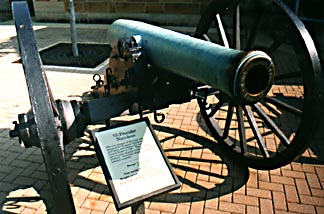
12-Pound Napoleon Field Gun, Model 1857
A bronze smoothbore developed in France in the 1850s for Emperor Napoleon III.Fired shot, shell, case shot, and canister. Maneuverable and effective at long range and against infantry assaults. Napoleons were used by both sides; the Federal version had a muzzle swell while the Confederate type had a straight tube. By mid-1863 nearly 40 percent of all the field artillery pieces in each army were Napoleons. The 12-pound shot was 4.5 inches in diameter. Tube was 66 inches long, weighed 1227 lbs., and the bore was 4.62 inches. Powder charge was 2.5 lbs. Range at 5 degree elevation was 1619 yards. (One mile equals 1760 yards.) Range of 2000 yards at 5 degree elevation. (One mile equals 1760 yards.)
Field Artillery No. 3
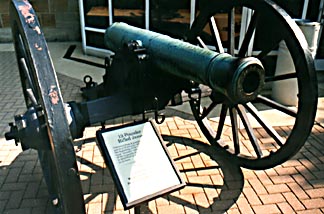
12-Pound Rifled James
This bronze gun was converted from a six-pound smoothbore to a 12-pound rifled gun at the beginning of the war. Charles T. James of the Rhode Island militia developed a projectile that could be used in any cannon specifically rifled for it (15 lands and grooves). In actuality, other ammunition was often substituted. The range at 5 degrees elevation was 1700 yards (one mile equals 1760 yards). It used solid shot, shell, and canister. The tube weighed 886 lbs.
Field Artillery No. 4
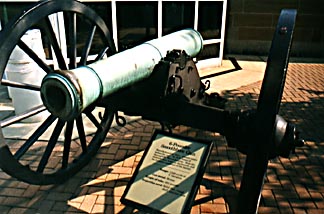
Six-Pound Smoothbore Gun, Model 1841
Nearly obsolete by the start of the war, this gun was used by both sides in the early years. It fired solid shot, round shell, canister, and case. Later, in the South, they were melted down; in the North they were rifled for James projectiles. The bronze tube was 60 inches long, weighed 884 lbs., and the bore was 3.67 inches. The range at 5 degrees elevation was 1523 yards. (One mile equals 1760 yards.)
Field Artillery No. 5
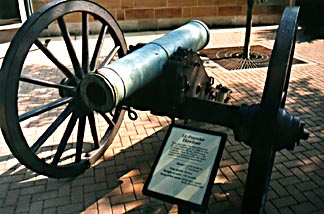
12-Pound Howitzer
This Confederate gun was manufactured in 1862 at the Tredegar Iron Works in Richmond, Va. This short barreled cannon fired at a higher trajectory than the Napoleon. The bronze tube is 53 inches long, weighs 788 lbs., and the bore is 4.62 inches. Used a one-pound powder charge. The range at 5 degrees elevation was 1072 yards. (One mile equals 1760 yards.)
Field Artillery No. 6
Three-Inch Ordnance Rifle
This sturdy, accurate wrought iron gun could shoot great distances. Developed by John Griffen in 1855. Considered superior to the Parrott, one thousand of these were bought by the North, and prized as captured weapons by the South. It usually shot Hotchkiss Schenkl patented shells or case shot. The tube is 73 inches long and weighs 816 lbs. The powder charge is one pound. The range at 5 degrees elevation was 1835 yards. (One mile equals 1760 yards.)
